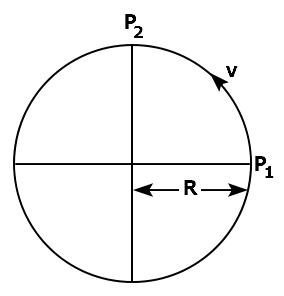A particle starting from the point \((1,2)\) moves in a straight line in the XY-plane. Its coordinates at a later time are \((2,3).\) The path of the particle makes with x-axis an angle of:
1.
\(30^\circ\)
2.
\(45^\circ\)
3.
\(60^\circ\)
4.
data is insufficient

To unlock all the explanations of this course, you need to be enrolled.

To unlock all the explanations of this course, you need to be enrolled.
A particle is projected from a horizontal plane (x-z plane) such that its velocity vector at time t is given by \(\overrightarrow{\mathrm{v}}=a \hat{i}+(b-c t )\hat{j}.\) Its range on this horizontal plane is given by:
| 1. | \(\frac{\mathrm{ba}}{\mathrm{c}} \) | 2. | \(\frac{2 \mathrm{ba}}{\mathrm{c}} \) |
| 3. | \(\frac{3 \mathrm{ba}}{\mathrm{c}} \) | 4. | None |

To unlock all the explanations of this course, you need to be enrolled.

To unlock all the explanations of this course, you need to be enrolled.
1. \(45^\circ\)
2. \(30^\circ\)
3. \(60^\circ\)
4. \(90^\circ\)

To unlock all the explanations of this course, you need to be enrolled.

To unlock all the explanations of this course, you need to be enrolled.
A river is 1 km wide. The banks are straight and parallel. The current is 5 km/h and is parallel to the banks. A boat has a maximum speed of 3 km/h in still water. In what direction should the boat head so as to arrive at point B directly opposite to its starting point A?
1. directly across the river
2. head upstream from the line AB
3. head
4. the trip from A to B is not possible with this speed

To unlock all the explanations of this course, you need to be enrolled.

To unlock all the explanations of this course, you need to be enrolled.
Two particles A and B, move with constant velocities \(\vec{v_1}\) and \(\vec{v_2}\) . At the initial moment their position vector are \(\vec{r_1}\) and \(\vec{r_2}\) respectively. The condition for particles A and B for their collision to happen will be:
1.
2.
3.
4.
A particle moves along a parabolic path y = 9x2 in such a way that the x component of the velocity remains constant and has a value of . It can be deduced that the acceleration of the particle will be:
1.
2.
3.
4.

To unlock all the explanations of this course, you need to be enrolled.

To unlock all the explanations of this course, you need to be enrolled.
Three balls are thrown from the top of a building with equal speeds at different angles. When the balls strike the ground, their speeds are respectively, then:
1.
2.
3.
4.

To unlock all the explanations of this course, you need to be enrolled.

To unlock all the explanations of this course, you need to be enrolled.
Figure below shows a body of mass M moving with a uniform speed v on a circular path of radius, R. What is the change in acceleration in going from P1 to P2?
1. zero
2.
3.
4.

To unlock all the explanations of this course, you need to be enrolled.

To unlock all the explanations of this course, you need to be enrolled.
A particle is projected with a speed u at an angle to the horizontal. Radius of curvature at highest point of its trajectory is?
1.
2.
3.
4.

To unlock all the explanations of this course, you need to be enrolled.

To unlock all the explanations of this course, you need to be enrolled.
Two particles A and B are moving in a uniform circular motion in concentric circles of radii \(r_A\) and \(r_B\) with speeds \(v_A\) and \(v_B\) respectively. Their time periods of rotation are the same. The ratio of the angular speed of \(A\) to that of \(B\) will be:
| 1. | \( 1: 1 \) | 2. | \(r_A: r_B \) |
| 3. | \(v_A: v_B \) | 4. | \(r_B: r_A\) |

To unlock all the explanations of this course, you need to be enrolled.

To unlock all the explanations of this course, you need to be enrolled.




